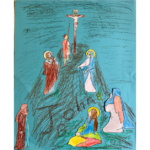
Who was Mary Magdalene?
It is believed that her name was derived from the place where she was from, a town called Magdala, near Tiberias, along the sea of Galilee. In fact she was also known as Mary of Magdala.
Her real identity has remained controversial throughout the centuries. Getting to know about Mary Magdalene, should not lead us along a path of seeking historical truth, but more importantly to seek the truth that God wants to reveal to us in so many ways through the Sacred Scriptures.
Sometimes she has been identified with:
- the anonymous woman who anointed the feet of Jesus in the house of Simon the Pharisee
- the sister of Martha and Lazarus
- the sinner who comes to Jesus early in His ministry, seeking pardon and from whom Our Lord cast out seven demons
- the woman who accompanied Jesus in His Public Ministry.
She is named more times in the Gospels than most of the Apostles. All the four evangelists record that Mary Magdalene was present at the most important events that are the cornerstone of our Faith. She was present at the Crucifixion when most of his followers, including the Apostles fled out of fear for their lives. She was also present when the lifeless Body of Our Lord was brought down from the cross and she helped in the entombment of His Sacred Body. She was the first recorded witness of the Risen Lord, alive and in person. Her statement “I have seen the Lord” continues to ‘ring’ through the centuries as she also became the first to announce to the Apostles the great news of the Resurrection.
The New Testament remains silent as to what Mary Magdalene did after these unique experiences. It is quite possible that she witnessed the Ascension as well as having been present at the experience of Pentecoste. With regards to her later life, tradition ties Mary Magdalene to two different anecdotes.
One tradition says that she retired to Ephesus with Our Lady and that she died there.
There is also a French tradition saying that together with Lazarus and his companions, she went to Marseille, where they eventually evangelized all Provence. There she retired to a cave in a hill until she died.
St. Mary Magdalene was given importance as an active disciple, having formed part, together with other women of the inner circle of the followers of Our Lord, at a time when women were not recognized for any kind of status. In this scenario, St. Mary Magdalene seems to provide a declaration that women also have a significant role to fulfill in the Church.
In fact, although she was not one of the Twelve Apostles, St. Thomas Aquinas called her “An Apostle of the Apostles.” Mary Magdalene moved from a possibly turbulent past to repentance that sought forgiveness and friendship with the Lord, becoming His faithful follower. Whatever her past was, Jesus never reprimanded her about her past failures.- When our children need to be reprimanded and disciplined, we can still be firm and respectful at the same time. Let us remember how important it is not to use harsh tones and not to belittle them by reminding them about past failures.












